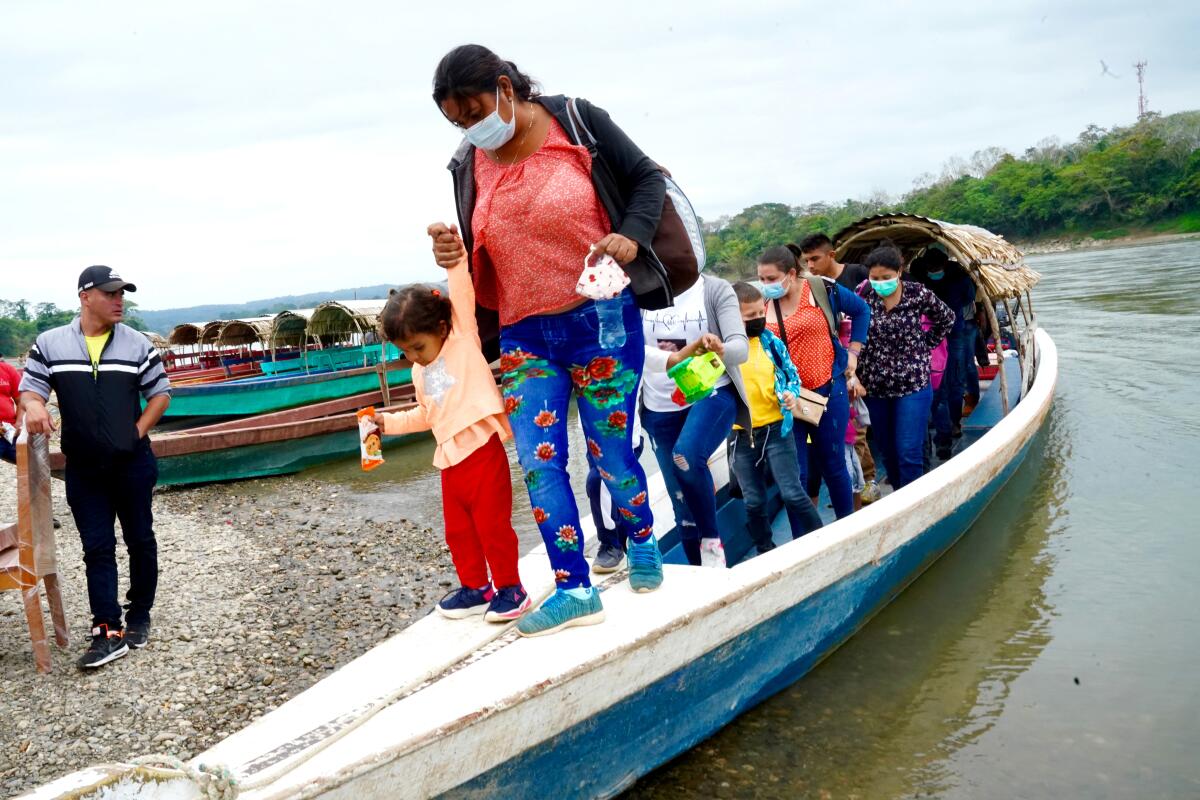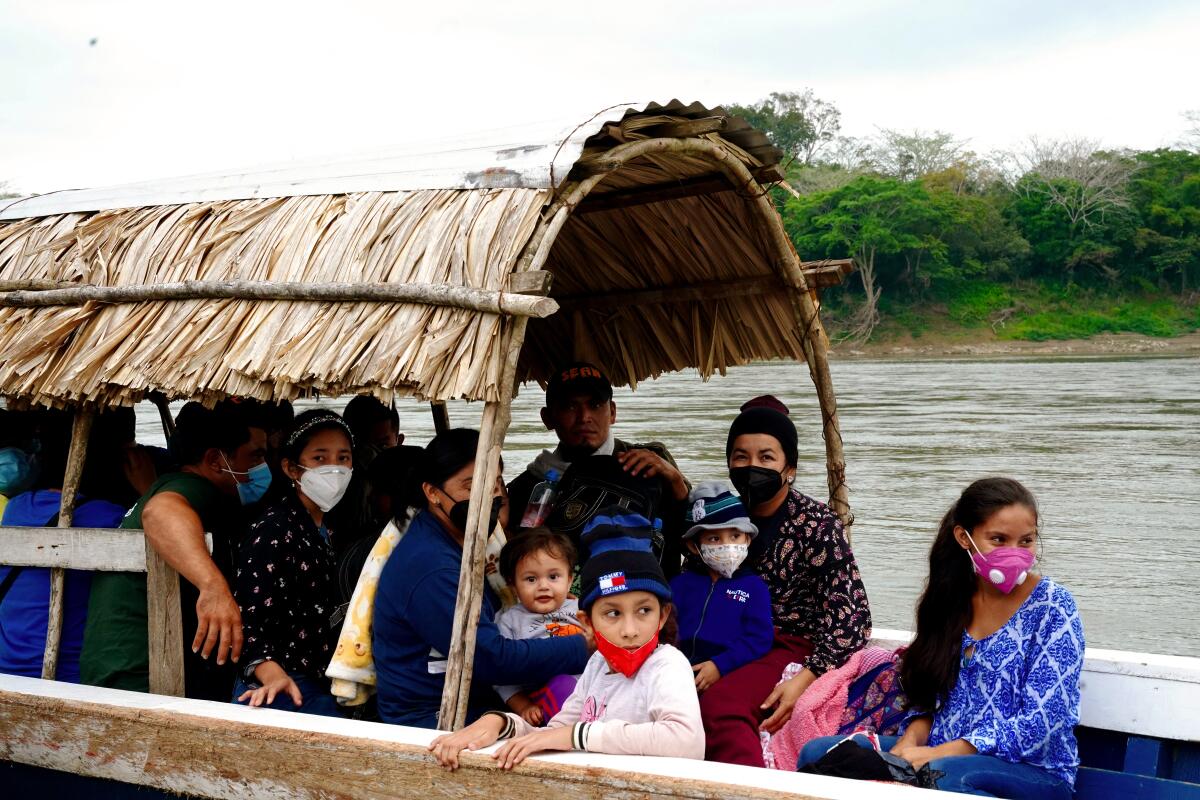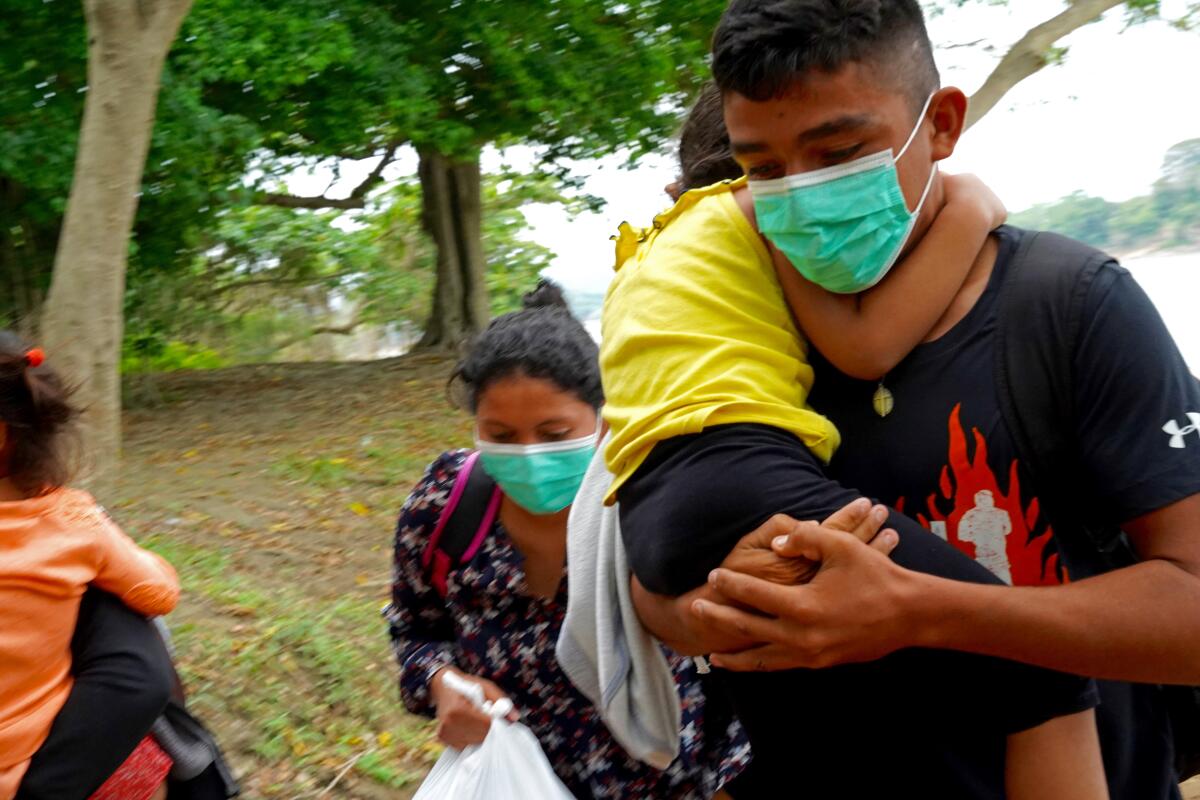The other Rio Grande: Central American migrants navigate jungle river en route to the United States

FRONTERA COROZAL, Mexico — A steady stream of boats packed with Central American migrants navigates a river that delineates the international boundary. Adults carrying babies and holding the hands of young children alight from the craft. Guides bearing cellphones point the way into a new country.
“Why am I here?” asked Norma Rodríguez, a U.S.-bound Honduran who was traveling with her children, ages 16, 11 and 3. “To find a better life for my family.”
Is this the Rio Grande, dividing Mexico and the United States? No, this is the Usumacinta River, which forms the border between Mexico and Guatemala in the Lacandon Jungle of Mexico’s southern Chiapas state.
The Usumacinta — where howler monkeys screech from overhanging trees, crocodiles lounge on sandbanks and jaguars prowl adjacent rainforest — is more than 1,000 miles from the mostly arid environs of the Rio Grande. But many of the migrants in the groups now arriving in southern Texas first entered Mexico via the Usumacinta and other jungle sites where there are no authorities present.
This vast, densely forested region has turned into a key human-smuggling corridor — and an imposing challenge for Mexican and U.S. authorities as they attempt to crack down on illicit migration.

The Biden administration, facing blowback from Republicans and others on its efforts to modify the Trump administration’s hard-line policies, on Monday dispatched to Mexico and Guatemala a high-level delegation including a pair of top aides: Roberta Jacobson, President Biden’s special assistant for border issues and a former ambassador to Mexico, and Juan S. González, the National Security Council’s top Latin America official.
The envoys are seeking help from Mexico and Guatemala in stemming the migrant flow.
Under U.S. pressure, Mexican authorities last week unveiled a series of measures, including closing Mexico’s border with Guatemala to all but essential traffic, such as international cargo. Though Mexican officials cited the COVID-19 pandemic, the move was widely viewed as a bow to a new U.S. administration worried about the expanding numbers of Central American migrants arriving at the southern border.
In addition, Mexico said it was bolstering law enforcement personnel at its border with Guatemala, a key entry point for U.S.-bound Central Americans.
Much of the new deployment of law enforcement officers appeared to be focused on the Suchiate River, which forms the far western flank of Guatemala’s 600-mile border with Mexico. Trump-era pressure on Mexico had already focused considerable resources on the Suchiate region, pushing many migrants farther west — often deep into the jungle, where there is little official presence on either side of the border.
“The [Mexico-Guatemala] border is very porous,” said Erubiel Tirado, a security expert at the Iberoamerican University in Mexico City. “The points of access, supposedly controlled, don’t have the minimum infrastructure to operate.”
During the Trump administration, Mexican authorities stationed thousands of national guard troops along major northbound highways leading from the Guatemalan border. Mexican authorities regularly intercept smuggling trucks and trailers ferrying hundreds of northbound Central American migrants, including unaccompanied children.
But officials acknowledge that many migrants go undetected, especially those arriving via the dense brush of the Lacandon Jungle, deep in the Maya heartland, where the border is largely unmonitored. Poor roads, ample hiding places and a highly developed network of smuggling transport and safe houses can make detection difficult. The jungle area is also notorious for northbound drug-trafficking.

In recent days, hundreds of migrants, many from Honduras, walked on the single paved road leading from the Usumacinta River to Palenque in Mexico, site of iconic Maya ruins and a key smuggling juncture. The only evidence of law enforcement along the two-lane road — past verdant pastures, dense forests and mountains — was an occasional police car, whose occupants paid little mind to the passing migrants.
Many migrants said in interviews that they traced their decision to emigrate to their poverty and Honduras’ notoriously corrupt political class, led by President Juan Orlando Hernández, a longtime Washington ally whom U.S. prosecutors now call an accomplice to international drug smugglers. The Honduran president denies the charges.
“The politics in Honduras is rotten,” said Alberto Gómez Pinera, 56, a farmer from Honduras’ western Lempira region, who spoke as he walked along the road in a group of eight, including Cintia Mariela Guzmán, 19; her son, 3; and an in-law, Clara Caballero, 17. “Everything in Honduras is for the haves. Nothing for we who have nothing.”
Like the other migrants, they had crossed the Usumacinta River on launches from Guatemala. The boats normally take ecotourists to Maya ruins, such as the spectacular site of Yaxchilán in Mexico, an hour’s boat ride from Frontera Corozal, a small river settlement. But the pandemic has wiped out the tourist trade. The revived migrant traffic has been a boon.
The boats bringing migrants arrive at a steady pace, some carrying only a few, some as many as two dozen or more. Most passengers are men, but many women and children make the journey too.
Luis Arcos, a municipal representative, downplayed the migrant traffic.
“It’s normal,” Arcos said after arriving at the boat slip with a group of security officials to check on a group of journalists who were making inquiries and taking photos at the remote spot. “This is a tourist site. We have a lot of people passing through.”
Once the migrants arrive on the sandy Mexican banks of the Usumacinta, a group of waiting taxis and cars provide northbound transport. Many migrants travel with “guides,” or smugglers, who help arrange the rides, dialing prearranged contacts on their cellphones.
It is a swift process. Within about 15 minutes, the 25 migrant occupants of a boat that arrived at the port on a recent afternoon had left the area, heading north.
Many are first ferried to safe houses along the route, where they stage with others until transportation is available to take them farther north. Some immediately take long-distance rides, having made arrangements with smugglers to whisk them away.
Others, the poorest, decamp on foot. It is a long haul. It can take four days to reach the Chiapas city of Palenque, some 100 miles from the Guatemalan border. The majority appear to arrive in Mexico nearly broke, having paid off bribes to police in Guatemala along the route.
Those stuck at a shelter in Palenque all said they couldn’t afford smugglers, who may charge $5,000 a person or more to move migrants to the U.S. border along the Rio Grande in Texas.
Many of them planned to try to hitch a ride on a network of northbound freight trains, collectively known as La Bestia (the Beast), but the trains are not currently running in the area, as the tracks are being renovated for the Maya Train, a pet tourist project of Mexican President Andrés Manuel López Obrador. Many migrants planned to try to move north into Veracruz state, where the freight train was still operating.
“We’re stuck here for now, but we plan to keep trying,” said Jairo Joel Quintanilla, 33, from the Honduran city of San Pedro Sula, also at the shelter.
He was traveling with his partner, Nora Leticia Castellanos, 33, and three children, ages 1, 8 and 13.
In Honduras, Quintanilla said, one heard all the time — from friends, on social media, from relatives — that this was a good moment to make a break for the United States, as long as one traveled with children.
Erlin Valle and a dozen relatives, mostly women and children, had set off a week earlier from the Honduran capital, Tegucigalpa, en route to the United States. They felt it was the right time.
“We’d heard, with the change of government in the United States, that it was easier now to get in if you brought children,” Valle, 40, said as she sat at a communal table at a migrant shelter in Palenque. “This seemed like an opportunity.”
Valle’s traveling group comprised four women, one man and eight children. Valle and two younger sisters, all with children, were the core of the group. They were headed to North Carolina, where another Valle sister resides.
Valle, a mother of four, brought her two youngest children along; the others remained in Honduras.
This seemed typical of families interviewed in the shelter — they often brought the younger kids and left the older ones at home. It appears to be both a logistical and a humanitarian decision — the younger children need additional care, and the older ones can be left with relatives back home in extended family support networks.
“We felt we’d have a better chance for our kids’ future in the north,” said Jessica Valle, 36, Erlin Valle’s sister, who was holding her 1-year-old daughter as shelter staff served a meal of rice, beans and pasta.
People ate the food joylessly. Some kids put their heads down on the long table to nap, having little else to do at the overcrowded Catholic refuge.
“Everyone knows that it’s supposed to be easier with kids now to cross the border” into the United States, Jessica Valle said. “At least that’s what everyone is saying.”
Special correspondents Liliana Nieto del Río in Frontera Corozal and Cecilia Sánchez in Mexico City contributed to this report.
More to Read
Sign up for Essential California
The most important California stories and recommendations in your inbox every morning.
You may occasionally receive promotional content from the Los Angeles Times.









